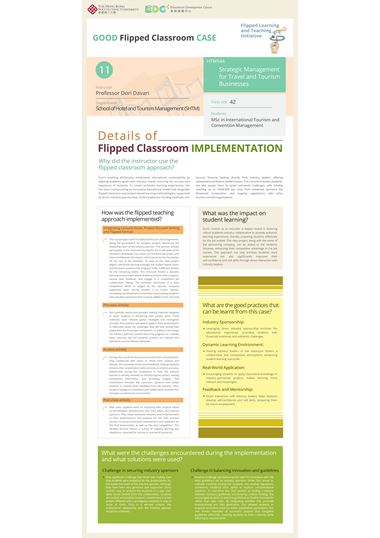
General Information
- Instructor: Prof Dori Davari
- Subject: HTM544 Strategic Management for Travel and Tourism Businesses
- Class Size: 42
- Students: MSc in International Tourism and Convention Management
Why Use the Flipped Classroom Approach?
Implementation Steps
The course begins with foundational lectures and assignments, laying the groundwork for complex projects defined by the leadership team of the industry sponsor. The sponsor actively participates in the classroom during the 3rd or 4th week of the semester, dedicating 3 to 4 hours to introduce the project and share confidential information, which becomes the foundation for the rest of the semester. As soon as the class project begins, interactive learning amongst the student teams starts; and the teams present their progress orally in different phases for the remaining weeks. This structure fosters a dynamic learning environment where students present their progress, receive peer feedback, and engage in a competitive yet collaborative setting. The semester culminates in a class competition which is judged by the sponsor company leadership team, during another 3 to 4-hour session, simulating a professional environment and providing students with valuable experience that could be added to their resumes.
Pre-class activity
Dori carefully selects and provides reading materials designed to assist students in enhancing their project work. These materials cover relevant global strategies and managerial concepts that students will need to apply in their presentations to effectively tackle the challenges they will face during their preparation for the project competition. In addition, Dori keeps the industry sponsors posted about the progress on a weekly basis, ensuring that the students’ projects are relevant and tailored to current industry demands.
In-class activity
During class, students discuss and practice their presentations. They collaborate with peers to refine their content and delivery. Dori provides constructive feedback, helping students enhance their presentation skills and ensure content accuracy. Additionally, during the competition in class, the industry sponsor is actively involved via introducing the project, sharing confidential information, and providing insights. This involvement enriches the classroom dynamic and allows students to receive direct feedback from the industry. Thus, students engage in competitive and collaborative activities that simulate a professional environment.
Post-class activity
After class, students work on improving their projects based on the feedback received from Dori, their peers, and industry sponsors. They make necessary revisions and enhancements to their presentations and prepare for the next practice session, ensuring continuous improvement and readiness for the final presentation, as well as the class competition. This iterative process fosters a culture of ongoing learning and adaptation, essential for success in real-world scenarios.
What Impact Did This Have on Student Learning?
What Are the Good Practices That Can Be Learnt from This Case?
Industry Sponsorship
Leveraging direct industry sponsorship enriches the educational experience, providing students with (financial) incentives and authentic challenges.
Dynamic Learning Environment
Hosting industry leaders in the classroom fosters a collaborative and competitive atmosphere, enhancing student learning outcomes.
Real-World Application
Encouraging students to apply theoretical knowledge in practical, industry-sponsored projects makes learning more relevant and meaningful.
Feedback and Mentorship
Direct interaction with industry leaders helps students develop self-confidence and soft skills, preparing them for future employment.
What were the challenges encountered during the implementation and what solutions were used?
One significant challenge Dori faced was making sure that students were prepared for the presentations for the leadership team of the industry sponsor. Although they have been very generous and supportive, Dori’s concern was to prepare the students in a way both sides would benefit from this collaboration. Students are excited and positive; however, involvement in a real project affiliated with a prestigious company is new to some of them. Only in a win-win context, the professional relationship with the industry sponsor would be sustained.
Challenge in balancing innovation and guidelines
Another challenge was balancing the need for innovation with the strict guidelines set by industry sponsors. While Dori aimed to cultivate creativity among her students, the existing regulations sometimes hindered their ability to explore unconventional solutions. To overcome this, Dori worked on finding a balance between necessary guidelines and fostering creative thinking. She encouraged students to view the guidelines as flexible frameworks rather than rigid rules. By integrating activities that promote brainstorming and idea generation, Dori allowed students to propose innovative solutions within established parameters. She also shared examples of successful projects that navigated guidelines effectively, inspiring students to think creatively while adhering to requirements.

